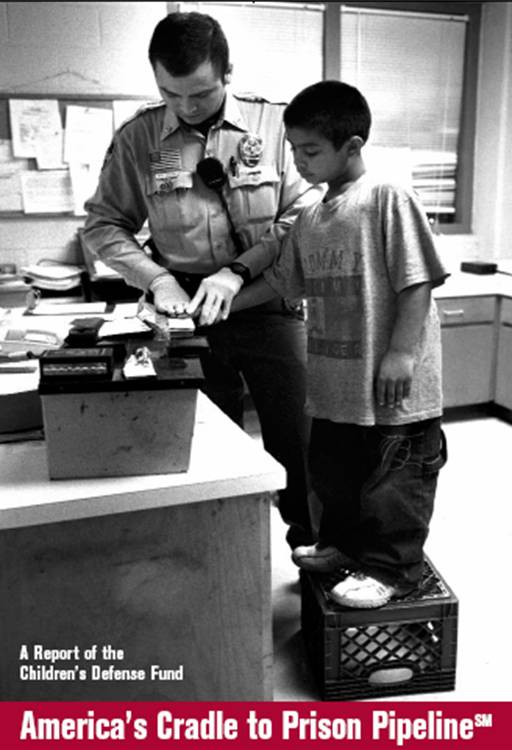What Is Juvienation?
Juvienation is written and published by Mark Sorkin, a journalist living in Brooklyn, New York. It is a news site covering developments in juvenile justice, a forum for exploring ideas on how to reform the system, and a resource for anyone interested in or curious about the subject. Along with regularly updated blog posts, Juvienation is also a repository of links to relevant articles, policy papers, websites and books. To join in the discussion visit: http://juvienation.wordpress.com |
|
America’s Cradle to Prison Pipeline
The Children’s Defense Fund has issued a new report, America’s Cradle to Prison Pipeline, documenting an urgent national crisis at the intersection of poverty and race that puts Black boys at a one in three lifetime risk of going to jail, and Latino boys at a one in six lifetime risk of the same fate.
The report was released at a national Cradle to Prison Pipeline® Summit at Howard University in Washington, DC that addressed the nationwide crisis and its devastating impact on children, youth and their families, particularly within the Black and Latino communities. Download the full report at:
www.childrensdefense.org.
|
 |
VADJJ FY 2007 Data Resource
Guide Released
Virginia Department of Juvenile Justice
The Virginia Department of Juvenile Justice has released the 2007 Data Resource Guide. First published in FY 2001, the guide has become a key source of information for those who work with system-involved children in the Commonwealth. The document provides descriptions of key programs and functions within the VADJJ, as well as demographic information and other data on court-involved young people. The information can be used to assess needs for the Commonwealth as a whole, as well as specific localities. The guide can be viewed or downloaded from the resources section of the Department of Juvenile Justice's website at: www.djj.virginia.gov/. |
|
Motivating Offenders to Change:
A Guide for Probation and Parol
National Institute of Corrections
This publication "provides probation and parole officers and other correctional professionals with both a solid grounding in the principles behind MI [motivational interviewing] and a practical guide for applying these principles in their everyday dealings with offenders" (p.2). Seven chapters are contained in this guide: how MI fits in with evidence-based practice; how and why people change; the motivational interviewing style; preparing for change; building motivation for change; navigating through tough times--working with deception, violations, and sanctions; and from start to finish--putting MI into practice. The publication can be viewed or downloaded from the resources section of the VJJA website or by visiting: http://nicic.org/library/022253/
|
|
Jailing Juveniles: The Dangers of Incarcerating Youth in Adult Jails in America
Campaign for Youth Justice
A new report released by the Campaign for Youth Justice provides a summary of the risks that youth face when incarcerated in adult jails, facts and figures about how many youth are incarcerated in jails nationwide, and a review of the limited federal and state laws protecting youth in jails.
The publication can be viewed or downloaded from the resources section of the VJJA website or by visiting www.campaignforyouthjustice.org |
|
Juvenile Delinquency Guidelines: Improving Court Practice in Juvenile Delinquency Cases
National Council of Juvenile & Family Court Judges
This publication is a benchbook of best practices developed by a committee of judges & other key professionals representing stakeholders in juvenile justice. The publication can be viewed or downloaded from the resources section of the VJJA website or by visiting the website of the National Council of Juvenile & Family Court Judges website at : www.ncjfcj.org/
|
|
Evidence-Based Practice to Reduce Recidivism: Implications for State Judiciaries
The reduction of recidivism by state judiciaries utilizing six principles of evidence-based practice (EBP) is explained. Seven sections follow an executive summary: introduction; current state sentencing policies and their consequences; drug courts -- the state judiciary's successful experiment with EBP; the principles of EBP; local sentencing and corrections policy reforms; state sentencing and corrections policy reforms; and conclusion. "[C]arefully targeted rehabilitation and treatment programs can reduce offender recidivism by conservative estimates of 10-20%" The publication can be viewed or downloaded from the resources section of the VJJA website or by visiting http://nicic.org/Library/022843
|
|
Gang Wars: The Failure of Enforcement Tactics & the Need for Effective Public Safety Strategies
Justice Policy Institute
report seeks to debunk pervasive myths about gang crime. “More police, more prison and more punishment have not stopped gang violence” The publication can be viewed or downloaded from the resources section of the VJJA website or by visiting www.justicepolicy.org
|
|
Tools of the Trade: A Guide to Incorporating Science Into Practice
National Institute of Corrections
Faye S. Taxman, et. al
The application of evidence-based research findings to the practice of offender supervision is explained. Sections of this manual include: introduction -- supervision as a behavioral management process to reduce recidivism; behavior and change; assessment and planning; communication tools; information tools; incentives to shape offender behavior; service tools; offender types; and guiding principles.The publication can be viewed or downloaded from the resources section of the VJJA website or by visiting: http://www.nicic.org/Library/020095 |
|
Beyond Detention
Annie E Casey Foundation
Book #14 in the Juvenile Detention Alternatives Initiative Pathways series on juvenile detention reform. It documents the ways in which detention reforms in general – and JDAI’s comprehensive reform model in particular -- stimulate and support other juvenile justice system improvements. The publication can be viewed or downloaded from the resources section of the VJJA website or by visiting www.aecf.org |
|
The Consequences Aren't Minor: The Impact of Trying Youth as Adults and Strategies for Reform.
Campaign for Youth Justice
This study examines the laws and data in seven key states: California, Connecticut, Florida, Illinois, North Carolina, Virginia, andWisconsin. An estimated 200,000 youth end up in the adult system each year, and 40 states allow or require the jailing of these youth in adult facilities before they ever go to trial.
The publication can be viewed or downloaded from the resources section of the VJJA website or by visiting www.campaignforyouthjustice.org |
|
Kids Are Different
John D. and Catherine T. MacArthur Foundation
The John D. and Catherine T. MacArthur Foundation funded the development of Understanding Adolescents: A Juvenile Court Training Curriculum, training materials for juvenile justice professionals, as a joint project of the Youth Law Center, Juvenile Law Center, and the American Bar Association Juvenile Justice Center. The result was a training curriculum that applies the findings of adolescent development and relates research to practice issues confronted by juvenile court practitioners at the various decision-making stages of the juvenile justice process. This set of publications can be viewed or downloaded from the resources section of the VJJA website or by visiting www.nccd-crc.org |
|
And Justice For Some: Differential Treatment of Youth of Color
National Council on Crime & Delinquency
This report details the accumulated disadvantage for youth of color as they move through the juvenile justice system and, too often, into the adult system. This publication can be viewed or downloaded from the resources section of the VJJA website or by visiting http://www.njdc.info/ |
|
Juvenile Offenders and Victims:
2006 National Report
Office of Juvenile Justice and Delinquency Prevention
This report cites FBI and other reliable research to provide a comprehensive and insightful view of the nature of juvenile crime and violence across the nation. This report offers the Congress, State legislators, local policymakers, professors, juvenile justice professionals, and concerned citizens solid answers to the most frequently asked questions about the nature of juvenile crime and victimization and about the justice system's response. This publication can be viewed or downloaded from the resources section of the VJJA website or by visiting http://ojjdp.ncjrs.org/
|
|
2007 KIDS COUNT Data Book: State Profiles of Child Well-Being
Annie E. Casey Foundation
This 18th annual KIDS COUNT Data Book provides national and state-by-state information and statistical trends on the conditions of America’s children and families. This year’s essay examines the child welfare system and challenges the country to make lifelong connections for children and youth in foster care a national priority. This publication can be viewed or downloaded from the resources section of the VJJA website or by visiting www.aecf.org
|
|
Justice by Gender: The Lack of Appropriate Prevention, Diversion & Treatment Alternatives for Girls in the Juv Just System
Jointly issued by the
American Bar Association and the National Bar Association
Over the last two decades we have witnessed a marked increase in the number of girls touched by, and and involved in, the juvenile justice system; yet this system seems singularly ill prepared to handle those cases. This publication can be viewed or downloaded from the resources section of the VJJA website or by visiting www.abanet.org
|
|
Juvenile Female Offenders: How Do You Meet Their Needs in Your Juvenile Justice Setting?
Office of Juvenile Justice & Delinquency Prevention &
National Institute of Corrections
Report presented at the 2006 National Juvenile Correctional and Detention Administrators Forum, Pittsburgh, PA. Topics covered include: introduction to the NIC and OJJDP collaboration; current perspective, research into juvenile female offender practice; current research -- a look at the work of OJJDPs Girls Study Group; and NICs approach to address the issue. The publication can be viewed or downloaded from the resources section of the VJJA website or by visiting http://www.nicic.org/Library/021453
|
|

|

